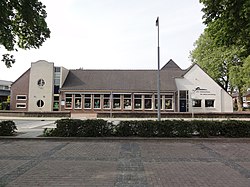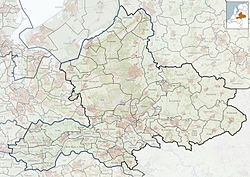
Arnhem is a city and municipality situated in the eastern part of the Netherlands. It is the capital of the province of Gelderland, located on both banks of the rivers Nederrijn and Sint-Jansbeek, which was the source of the city's development. Arnhem had a population of 163,972 on 1 December 2021, which made it one of the larger cities of the Netherlands. The municipality is part of the Arnhem–Nijmegen metropolitan area, which has a combined number of 774,506 inhabitants on 31 January 2022.

Operation Market Garden was an Allied military operation during the Second World War fought in the German-occupied Netherlands from 17 to 27 September 1944. Its objective was to create a 64 mi (103 km) salient into German territory with a bridgehead over the Nederrijn, creating an Allied invasion route into northern Germany. This was to be achieved by two sub-operations: seizing nine bridges with combined US and British airborne forces (Market) followed by British land forces swiftly following over the bridges (Garden).

Gelderland, also known as Guelders in English, is a province of the Netherlands, occupying the centre-east of the country. With a total area of 5,136 km2 (1,983 sq mi) of which 173 km2 (67 sq mi) is water, it is the largest province of the Netherlands by land area, and second by total area. Gelderland shares borders with six other provinces and the German state of North Rhine-Westphalia.

Overbetuwe is a municipality in the province of Gelderland in the Netherlands. It was formed on 1 January 2001 as a merger of three former municipalities: Elst, Heteren and Valburg. Overbetuwe is bordered in the north by the river Rhine and in the south by the river Waal. The city hall is located in Elst, the largest town in the municipality. Together with eighteen other municipalities it forms the 'Knooppunt Arnhem-Nijmegen', or simply 'KAN', which is a regional collaboration.
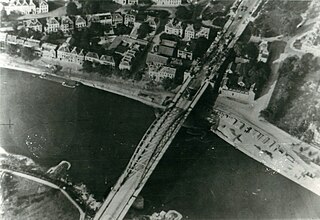
The Battle of Arnhem was a battle of the Second World War at the vanguard of the Allied Operation Market Garden. It was fought in and around the Dutch city of Arnhem, the town of Oosterbeek, the villages Wolfheze and Driel and the vicinity from 17 to 26 September 1944. The Allies were poised to enter the Netherlands after sweeping through France and Belgium in the summer of 1944, after the Battle of Normandy. Operation Market Garden was proposed by Field Marshal Sir Bernard Montgomery, who favoured a single push northwards over the branches of the Lower Rhine River, allowing the British Second Army to bypass the Siegfried Line and attack the Ruhr. US Airborne troops were dropped in the Netherlands to secure bridges and towns along the line of the Allied advance. Farthest north, the British 1st Airborne Division landed at Arnhem to capture bridges across the Nederrijn, supported by men of the Glider Pilot Regiment and the 1st Polish Parachute Brigade. The British XXX Corps were expected to reach the British airborne forces in two to three days.

Operation Pegasus was a military operation carried out on the Lower Rhine near the village of Renkum, close to Arnhem in the Netherlands. Overnight on 22–23 October 1944, Allied military forces, Britain's MI9 intelligence organization, and the Dutch Resistance evacuated 138 men, mostly soldiers trapped in German-occupied territory who had been in hiding since the Battle of Arnhem a month earlier.

Stanisław Franciszek Sosabowski was a Polish general in World War II. He fought in the Polish Campaign of 1939 and at the Battle of Arnhem (Netherlands), as a part of Operation Market Garden, in 1944 as commander of the Polish 1st Independent Parachute Brigade.

The 1st (Polish) Independent Parachute Brigade was a parachute infantry brigade of the Polish Armed Forces in the West under the command of Major General Stanisław Sosabowski, created in September 1941 during the Second World War and based in Scotland.

Oosterbeek is a village in the eastern part of Netherlands. It is located in the municipality of Renkum in the province of Gelderland, about 5 km (3.1 mi) west of Arnhem.
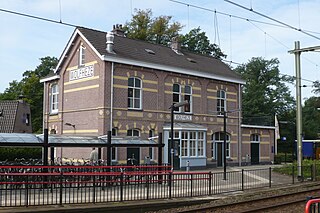
Wolfheze is a village in the Dutch province of Gelderland. It is located in the municipality of Renkum, 10 km northwest of the city of Arnhem.

The 4th Parachute Brigade was an airborne, specifically a parachute infantry, brigade formation of the British Army during the Second World War. Formed in late 1942 in the Mediterranean and Middle East, the brigade was composed of three parachute infantry units, the 10th, 11th and 156th Parachute Battalions.

The Battle of Overloon was a battle fought in the Second World War battle between Allied forces and the German Army which took place in and around the village of Overloon in the south-east of the Netherlands between 30 September and 18 October 1944. The battle, which resulted in an Allied victory, ensued after the Allies launched Operation Aintree. The Allies went on to liberate the town of Venray.
This article lists some of the events that took place in the Netherlands in 2006.

Heteren is a village in the Dutch province of Gelderland. It is located in the municipality of Overbetuwe, about 12 km southwest of Arnhem on the south bank of the Rhine.

The Airborne Museum ‘Hartenstein’ in Oosterbeek, The Netherlands is dedicated to the Battle of Arnhem in which the Allied Forces attempted to form a bridgehead on the northern banks of the Rhine river in September 1944. Hartenstein served as the headquarters of the British 1st Airborne Division. In the museum an extensive and diverse collection is displayed consisting of original weaponry, genuine uniforms and equipment used in the battle. The numerous photos and films on display provide a realistic picture which is enhanced by interviews with Allied soldiers. In addition the museum has an award-winning Airborne Experience exhibition, that depicts the area around Arnhem and Oosterbeek during the battle. The museum also provides German and civilian perspectives.
Operation Berlin was a night-time evacuation of the remnants of the beleaguered British 1st Airborne Division, trapped in German-occupied territory north of the Lower Rhine in the Netherlands during Operation Market Garden in the Second World War. The aim of the operation was to withdraw safely the remnants of the division while covered by the 1st Polish Parachute Brigade and surrounded on three sides by superior German forces and in danger of being encircled and destroyed.

The Arnhem Oosterbeek War Cemetery, more commonly known as the Airborne Cemetery, is a Commonwealth War Graves Commission cemetery in Oosterbeek, near Arnhem, the Netherlands. It was established in 1945 and is home to 1764 graves from the Second World War besides 4 later non-war graves and there are special memorials of two personnel buried elsewhere. Most of the men buried in the cemetery were Allied servicemen killed in the Battle of Arnhem, an Allied attempt to cross the Rhine in 1944, or in the liberation of the city the following year. Men killed in these battles are still discovered in the surrounding area even in the 21st century, and so the number of people interred in the cemetery continues to grow.

The Battle of Nijmegen, also known as the Liberation of Nijmegen, occurred from 17 to 20 September 1944, as part of Operation Market Garden during World War II.
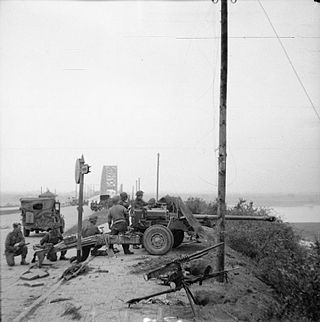
The Battle of the Nijmegen salient or the Defence of the Nijmegen bridgehead was a series of engagements that took place in the Netherlands during World War II between 30 September and 8 October 1944. The battle occurred in the aftermath of Operation Market Garden, a failed attempt by the Allies to cut off German forces in the Netherlands and end the war quickly.
The evacuation of Arnhem was the departure, forcibly conducted by the German Wehrmacht, of tens of thousands of inhabitants of the Dutch city of Arnhem and nearby places from 23 to 25 September 1944 during the Battle of Arnhem in World War II. The occupying German forces decided to evacuate almost the entire civilian population in order to better defend the city against the Allied Operation Market Garden. After the city was evacuated, many houses and other buildings were looted by various groups of organised and unorganised German soldiers and pro-German collaborators.
